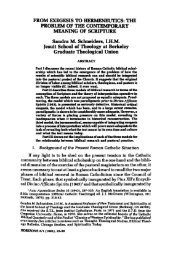WIFE AND SISTER THROUGH THE AGES - Blessed Edmund Rice ...
WIFE AND SISTER THROUGH THE AGES - Blessed Edmund Rice ...
WIFE AND SISTER THROUGH THE AGES - Blessed Edmund Rice ...
You also want an ePaper? Increase the reach of your titles
YUMPU automatically turns print PDFs into web optimized ePapers that Google loves.
122 SEMEIAtion, are interesting but have not been convincing (Christiansen: 99-133).3Far more obvious is the influence of the interests of the interpreter and thecommunity on the specific form of the allegory. Conventions resident inthe interpretive community allow allegorical interpretation, while theinterpreter's specific interests direct the details. Philo's specific concernsare too extensive to review here. His general goals are admirably summarizedby Peder Borgen in a recent survey of Philo's influence.It may be maintained that Philo attempts to make the allegorical methodserve his aims as a Jewish exegete. ... He spells out abstract principles whichhe sees in the biblical text, and these in turn can be applied to individuals andthe Jewish community, serving to interpret specific events. Philo also adaptsallegorical interpretation to the Jewish notion of election, which he uses toclaim for the Jews and their sacred writings elements from Greek philosophy,education, ethics, and religion. Conversely, to Philo allegorical interpretationis a way in which the wisdom of the laws of Moses and Jewish religiousinstitutions can be disclosed to the world (Borgen: 262).Allegorical interpretation allows biblical application to specific contemporaryevents, and mediates for the interpretive community the interactionbetween Jewish biblical tradition and religious institutions, on one side,and dominant elements of Hellenistic thought and culture on the other. Inthis mediation the matter of textual control absorbs relatively littleattention. Opponents did not press individual allegories, which mighthave forced the question of textual control. Some opponents contested thepropriety of allegorical interpretation, others went too far, in Philo's view,allegorizing the texts enjoining such fundamental Jewish customs as theSabbath (Borgen: 260-1). Philo guarded against excessive allegorical interpretationby maintaining the literal interpretation concurrently and by restraintin applying allegory to sensitive texts. The argument supportingallegorical interpretation was simple: allegory was a recognized form ofinterpretation in the community and, the proof of the pudding, it reacheda higher level of meaning in the text. Why would anyone be content withjust the literal meaning? Specific allegories are not contested on eitherfront, damping a pressure that might otherwise have required closerscrutiny of the relation between text and allegorical interpretation. Theallegorical interpretation enjoys a great deal of freedom, as the situationrequires. Validation of that interpretation depends on the strength of theallegorical convention, the acceptance of the method, including suchfeatures as the etymology of names. It depends equally on the depth ofthe community's need for the mediation between Jewish and Hellenisticcultures and Philo's exegetical success in providing that mediation.3 "a rather desperate suggestion" (Dillon: 77).



